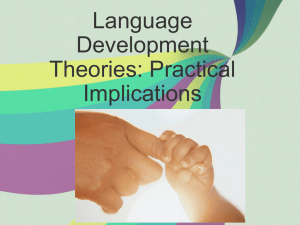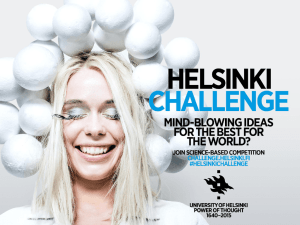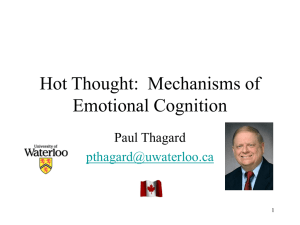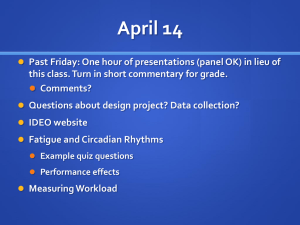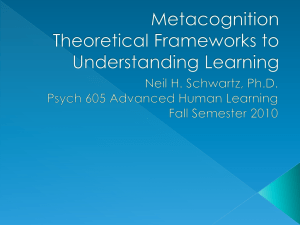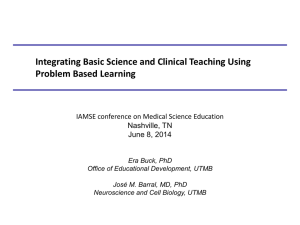(Revised) presentation slides
advertisement
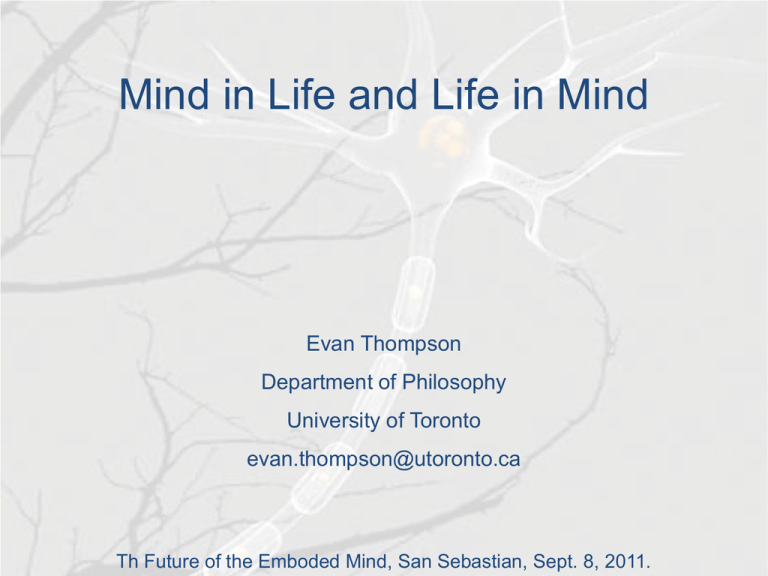
Mind in Life and Life in Mind Evan Thompson Department of Philosophy University of Toronto evan.thompson@utoronto.ca Th Future of the Emboded Mind, San Sebastian, Sept. 8, 2011. Guiding questions • How is life related to mind and mind related to life? • What is the place of the living body in an understanding of mind? Traditional view in cognitive science • Life is not necessary for mind and mind is not necessary for life: • There can be living systems that aren’t cognitive systems (all organisms without nervous systems of sufficient complexity). • There can be cognitive systems that aren’t living systems (AI systems, robots). Enactive life-mind continuity thesis • Any living system is ipso facto a cognitive system (life is sufficient for mind). • What makes a system living and therefore cognitive is its autonomy. • Understanding cognition requires understanding the principles of biological autonomy. Outline • • • • • • Enactive propositions Relation to the sensorimotor contingency theory Cognition and emotion Relation to the extended cognition thesis Is life necessary for mind? The problem of consciousness Enactive propositions 1. Autopoiesis (self-production) and adaptivity (self-regulation with respect to the system’s viability conditions) are necessary and sufficient for life. Basic biologic (autopoiesis & adaptivity) determine energy, chemicals molecular components bounded system protein DNA, RNA generates produces metabolic reaction network Maturana & Varela 1980 Enactive propositions 2. Autopoiesis is the paradigm case of autonomy—the best understood and minimal case of an autonomous organization. A system is (adaptively) autonomous when its constituent processes • • • • Form a thermodynamica lly open network. Have organizational closure. Generate and sustain a relational identity under precarious conditions. Specify a meaningful Adapted from Di Paolo Autonomy and adaptivity Regulation Organizational closure ENV Adapted from Froese & Di Paolo 2011 Enactive propositions 3. Autonomy and adaptivity are necessary and sufficient for agency and sense-making. Agency • Individuality (system defines its own individuality) • Interactional asymmetry (system is an active source of directed activity in relation to its environment) • Normativity (system self-regulates in relation to norms of activity) Barandiaran, Di Paolo & Rohde 2009 Sense-making • An adaptive autonomous system constitutes a perspective from which encounters have significance for the system. • The environment is thereby a place of significance and valence for the system—a world (Umwelt). Varela 1984, 1991, 1997 Sense-making • Sensitivity to environmental conditions. • Significance of environmental conditions for the system. • Directedness of the system in response to the valence of environmental conditions (approach/avoid). Protevi 2011 Enactive propositions 4. Living is sense-making in precarious conditions. Enactive propositions 5. Cognition—being directed toward objects as unities-in-manifolds of appearance with spatial (foreground-background) and temporal (pastpresent-future) horizons—is a kind of sensemaking linked to movement and the nervous system. The Nervous System Cognition-emotion Regulation (Agency) Nervous system ENV Organizational closure Adapted from Di Paolo Basic neurologic Modulates the dynamics of Sensorimotor linkage Nervous system generates Neuronal ensembles underlying Modulates the dynamics of Sensorimotor linkage Nervous system generates determine energy, chemicals Neuronal ensembles underlying molecular components bounded system protein DNA, RNA produces metabolic reaction network generates Sensorimotor sense-making Influences development of attracts Niche = Affordances Modulates the dynamics of Sensorimotor Coupling ENACTION Nervous system generates brings forth Perception-Action Neuronal ensembles underlying Autonomous System Adapted from Chemero Outline • • • • • • Enactive propositions Relation to the sensorimotor contingency theory Cognition and emotion Relation to the extended cognition thesis Is life necessary for mind? The problem of consciousness Relation to the SM contingency theory • The enactive approach and the SMCT are compatible (though individual theorists may diverge on particular issues). • Nevertheless, from the enactive perspective, the SMCT lacks a proper theoretical grounding. Thompson 2005, 2007 Relation to the SM contingency theory Enactive critique: • The SMCT lacks a proper account of agency and action. • There is no genuine sensorimotor knowledge and exercise of such knowledge in action [≠ movement] unless the system is a sense-making agent, and this requires the system to be adaptively autonomous (have an autonomous organization with adaptivity) – a missile guidance system (O’Regan & Noë 2001) is not an autonomous agent (and hence has no SM Thompson 2005, 2007 mastery). Link to dynamical neuroscience • The nervous system as an autonomous system both shapes and is shaped by sensorimotor processes. • SM knowledge (mastery of SM contingencies) depends on large-scale brain integration via oscillatory rhythms and synchrony (arising endogenously and occuring far from sensors and effectors). • Such integration is especially crucial for actions that are not movements (e.g., remembering, anticipating, planning, empathizing, etc.). Engel et al. 2001; Varela et al. 2001 Outline • • • • • • Enactive propositions Relation to the sensorimotor contingency theory Cognition and emotion Relation to the extended cognition thesis Is life necessary for mind? The problem of consciousness Cognition and emotion • • Sense-making is viable conduct in relation to what has significance and valence—what attracts or repels, elicits approach or avoidance. Emotion—motivated action tendencies and affect regulation—constitutes animal sensemaking as much as cognition. Cognition and emotion “Complex cognitiveemotional behaviours have their basis in dynamic coalitions of networks of brain areas, none of which should be conceptualized as specifically affective or cognitive” (Pessoa 2008, 148). Pessoa 2008 Cognition and emotion • • From the enactive perspective, cognition as sense-making is fundamentally a matter of adaptive self-regulation in precarious conditions, not abstract problem-solving. The narrow cognition of problem-solving presupposes the broader emotive cognition of sense-making [cf. relevance and the frame problem]. Outline • • • • • • Enactive propositions Relation to the sensorimotor contingency theory Cognition and emotion Relation to the extended cognition thesis Is life necessary for mind? The problem of consciousness The enactive view • Cognition as emotive sense-making implies that cognition is not body neutral: – – The body strongly shapes how and what an organism cognizes. There is no clearly definable interface between strictly cognitive processes and extracognitive (e.g., somatic) processes. The body and the EC thesis • The cognitive role of the body is exhausted by its playing a certain functional role in a problemsolving organization that extends across brain, body, and world. • It is merely a contingent fact that the body is living (a metabolic system). Clark 2008a, 2008b Enactive criticisms • • The cognitive role of the body in EC nowhere includes emotion. Cognition extends beyond the brain to include the sensorimotor body (characterized in functional/computational terms), but remains compartmentalized in relation to the emotive and affective body. Enactive criticisms • The inseparability of cognition and emotion counts as evidence favouring the crucial role of the living body in sense-making. • It also counts as evidence against multiple realizability (in the strict functionalist sense), though it is perfectly compatible with compositional plasticity (e.g., neural plasticity). Enactive view • The EC view lacks a theory of what a body is, so its conception of embodiment is empty and theoretically ungrounded. • Minimally, a body is a self-constituting and sense-making system (adaptive autonomy in precarious conditions). • As such, it is the precondition for having a meaningful world (Jonas, Merleau-Ponty). Enactive view • Both the brain and body are compositionally plastic – they can alter their structure and dynamics by incorporating processes, tools, and resources that go beyond what the biological body can metabolically generate. • Such incorporation can happen thanks to the body’s adaptive, self-constituting dynamics. Thompson & Stapleton 2009 Summary Enactive • Provides a theory of the body • Compositional plasticity • Incorporation by the lived body • Cognition-emotion as adaptive selfregulation in precarious conditions (sense-making) Extended • Lacks a theory of the body • Multiple realizability • Extended functionalism • Cognition as problemsolving Outline • • • • • • Enactive propositions Relation to the sensorimotor contingency theory Cognition and emotion Relation to the extended cognition thesis Is life necessary for mind? The problem of consciousness Enactive research question • Can cognition-emotion (sense-making) be realized by nonmetabolic systems? • Is adaptive autonomy achievable (at some level) without autopoietic (metabolic) grounding? [Enactive challenge: can we construct a model of an autonomous system that is not an autopoietic system or that does not depend constitutively on autopoietic components?] Standard enactive view • Sensorimotor adaptive autonomy can be implemented directly without autopoiesis, e.g., in robots or animats that do not depend for their functioning on metabolic subsystems. Questioning the standard enactive view • Sense-making requires a self-constituting system that can adaptively regulate its sensorimotor interactions in precarious conditions. • This implies the system must bring forth its own sensors, effectors, and their internal organizational link on the basis of its selfconstituting operations. • So far no one has been able to generate artificially such a system. • It may be that only a metabolic (autopoietically based) system could instantiate such autonomy Froese & Ziemke 2009 and sense-making. Compare Jonas on metabolism • A mode of being in which the system’s being is its own doing (metabolic self-construction). • The constitution of a meaningful perspective by that process for that process: o Emergence of a distinct individual in precarious conditions. o Basic normativity in relation to which events are good or bad for the continuation of this individual. • A world of significance is encountered only by such systems whose being is their own doing (living bodies). Jonas 1966 Life-mind equivalence thesis • Life is sufficient for mind (mind is necessary for life): – any living system is a cognitive system. • Life is necessary for mind (mind is sufficient for life): – any genuine cognitive system must also be a living system. Outline • • • • • • Enactive propositions Relation to the sensorimotor contingency theory Cognition and emotion Relation to the extended cognition thesis Is life necessary for mind? The problem of consciousness The problem of consciousness • • Is consciousness embodied in the sense that it is minimally realized by the body and brain working together and not just the brain? Or is the body only causally supportive (and not constitutive) of the biological basis of consciousness? Andy Clark’s extended cognition thesis • • The extended cognition thesis does not apply to consciousness. The minimal physical basis for consciousness is the brain and does not include the (nonneural) body and the environment. Clark 2008a, 2008b, 2009 Andy Clark’s extended cognition thesis “the external environment may well matter insofar as it drives the neural systems [causation], but the key effects [conscious contents] may then be occurring at time-scales that are possible only within the neural apparatus itself. If this were so, then everything that involves subsequent motor actions or bodily actions… will be ‘screened off’ (by the bodily ‘low-pass filter’) from the neural/CNS mechanisms that actually produce [constitute/realize] the conscious experience.” Clark 2009 Clark’s argument • • • • The (extra-neural) body acts as a low-pass filter for signals coming from the environment. The contents of conscious experience require certain fast time-scales (e.g., for temporal/feature binding). As a matter of fact, the only locus where such highspeed operations occur is the brain (and does not span the brain-body-world). So the minimal physical substrate for consciousness lies entirely within the brain (does not extend to include the nonneural body). Clark 2009 A (not so interesting) problem • • The time it takes for visual stimulation to pass through the lens and reach the first stages of neural processing is a fraction of the time it takes for neural systems to build up any correlated activity (from retina to early visual areas in recurrent loops with higher visual areas and frontal and parietal regions). So the “band-pass” argument as stated does not work. Thompson & Cosmelli 2012 A (more interesting) problem • • Clark’s treats the problem of consciousness as the problem of explaining phenomenal state consciousness for a given sensory modality. The more fundamental problem is to explain creature consciousness (sentience, the feeling of being alive and having a world), which is domain-general, not modality specific. Thompson & Cosmelli 2012 A (more interesting) problem • • • • Can creature consciousness be explained only in terms of neural processing “screened off” from the body? This seems unlikely. Life-regulation and sensorimotor coupling are not strictly neural phenomena. They are system features of adaptive autonomy (which spans and interconnects brain, body, and environment). Cosmelli & Thompson 2010; Thompson & Cosmelli 2012 A (more interesting) problem • • • Clark’s argument targets phenomenal contents of particular states and neglects the phenomenal structure of being a body-in-theworld—the lived body. The lived body—the body as living and as having the feeling of being alive—appears nowhere in the extended cognition viewpoint, not even when it turns its attention to consciousness. By contrast, the lived body is the centrepiece of the enactive approach. Putting life back into consciousness The enactive working assumption: The minimal realizing system for creature consciousness(the lived body) is not the brain (or some neural subsystem), but rather a whole living system, understood as an adaptively autonomous system made up of some crucial set of densely coupled and nonseparable neuronal and extraneuronal subsystems. Cosmelli & Thompson 2010; Thompson & Cosmelli 2012 Putting life back into consciousness This proposal transforms how we think about the explanatory gap. Thompson 2007 Putting life back into consciousness • • • • The explantory gap is no longer between the mental (defined as not fundamentally physical) and the physical (defined as not fundamentally mental). It is rather the gap between the living body and the lived body. How does a living body become also a lived body? The body-body problem. Thompson 2007 The task before us To understand the emergence of living subjectivity from living being and the reciprocal shaping of living being by living subjectivity. Thompson 2007 Mutual enlightenment & reciprocal constraints Phenomenology Life: the Living/Lived Body Systems biology & Cognitive science Thompson 2007; Varela 1996; Varela, Thompson & Rosch 1991 References • Bachman, P.A., Luisi, P.L. and Lang, J. (1992). Autocatalytic selfreplicating micelles as models for prebiotic structures. Nature 357: 5759. • Barandiaran, X. Di Paolo, E., and Rhode, M. (2009) Defining agency: individuality, normativity, asymmetry, and spatiotemporality in action.” Adaptive Behavior 17: 367-386 • Bourgine, P. and Stewart, J. (2004). Autopoiesis and cognition. Artificial Life 20: 327-345. • Clark, A. (2008a) Supersizing the Mind. Oxford: Oxford University Press. • Clark, A. (2008c) Pressing the flesh: a tension in the study of the embodied, embedded mind? Philosophy and Phenomenological Research 76: 37-59. • Clark, A. (2009) Spreading the joy: why the machinery of consciousness is (probably) still in the head. Mind 118: 963-993. • Di Paolo, E.A. (2005). Autopoiesis, adaptivity, teleology, agency. • Engel, A.K., Fries, P., and Singer, W. (2001). Dynamic predictions: Oscillations and synchrony in top-down processing. Nature Reviews Neuroscience 2: 704-716. • Fodor, J. (2009) Where is my mind? Review of Andy Clark, Supersizing the Mind. London Review of Books 31: 13-15. • Froese, T. and Di Paolo, E. (2011) The enactive approach: theoretical sketches from cell to society. Pragmatics & Cognition 19: 1-36. • Froese, T. and Ziemke, T. (2009) Enactive artificial intelligence: investigating the systemtic organization of life and mind. Artificial Intelligence 173: 466-500. • Hurley, S. (2010) The varieties of externalism. In Richard Menary, ed., The Extended Mind (Cambridge, MA: The MIT Press, 2010). • Jonas, H. (1966). The Phenomenon of Life: Toward a Philosophical Biology. Chicago: University of Chicago Press. Reprinted by Northwestern University Press, 2000. • Lewis, M.D. (2005). Bridging emotion theory and neurobiology through dynamic systems modeling. Behavioral and Brain Sciences 28: 169194. • Maturana, H.R. (1970). Biology of cognition. In H.R. Maturana and F.J. • Maturana, H. R. and Varela, F J. (1980). Autopoiesis and Cognition: The Realization of the Living. Boston Studies in the Philosophy of Science, vol. 42. Dordrecht: D. Reidel. • Pessoa, L. (2008) On the relationship between emotion and cognition. Nature Reviews Neuroscience 2:148-58. • Shapiro, L.A. (2004) The Mind Incarnate. Cambridge, MA: The MIT Press. • Thompson, E. (2005) Sensorimotor subjectivity and the enactive approach to experience. Phenomenology and the Cognitive Sciences 4: 407-427. • Thompson, E. (2007) Mind in Life: Biology, Phenomenology and the Sciences of Mind. Cambridge, MA: Harvard University Press. • Thompson, E. and Cosmelli, D. (2010) Embodiment or envatment? Reflections on the bodily basis of consciousness. In John Stewart, Olivier Gapenne, and Ezequiel Di Paolo, eds., Enaction: Toward a New Paradigm for Cognitive Science (Cambridge, MA: The MIT Press, 2010), pp. 361-385 • Thompson, E. and Cosmelli, D. (2012) Brain in a vat or body in a world? Brainbound versus enactive views of experience. Philosophical Topics, in press. • Varela, F.J. (1996). Neurophenomenology: a methodological remedy for the hard problem. Journal of Consciousness Studies 3: 330-350. • Varela, F.J. (1997). Patterns of life: intertwining identity and cognition. Brain and Cognition 34: 72-87. • Varela, F.J. (1991). Organism: a meshwork of selfless selves. In A. Tauber, ed., Organism and the Origin of Self, pp. 79-107. Dordrecht: Kluwer Academic Publishers. • Varela, F.J. (1979). Principles of Biological Autonomy. New York: Elsevier North Holland. • Varela, F.J. (1984). Living ways of sense-making: a middle path for neuroscience. In P. Livingston, ed., Disorder and Order: Proceedings of the Stanford International Symposium, pp. 208-224. Stanford Literature Series, vol. 1, Anma Libri. • Varela, F.J., Lachaux, J.-P., Rodriguez, E., and Martinerie, J. (2001). The brainweb: phase synchronization and large-scale integration. Nature Reviews Neuroscience 2: 229-239. • Varela, F.J., Thompson, E. and Rosch, E. (1991). The Embodied Mind: Cognitive Science and Human Experience. Cambridge, MA: The MIT Press. • Wheeler, M. (2010) Mind, things, and materiality. In Renfrew C. and Malafouris L. (eds.), The Cognitive Life of Things: Recasting the Boundaries of the Mind, McDonald Institute for Archaeological Research Publications, Cambridge.
